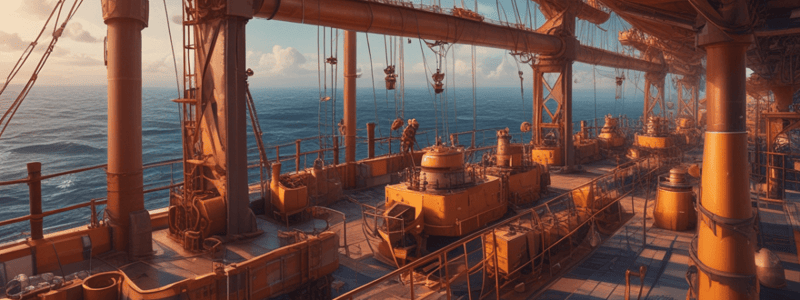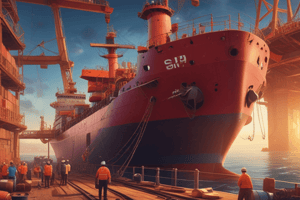Podcast
Questions and Answers
What is the significance of the term 'Gross Tonnage' in relation to a vessel's size?
What is the significance of the term 'Gross Tonnage' in relation to a vessel's size?
Gross Tonnage is a function of the moulded volume of specific enclosed spaces on a vessel.
How does 'Net Tonnage' differ from 'Gross Tonnage' in terms of a vessel's size?
How does 'Net Tonnage' differ from 'Gross Tonnage' in terms of a vessel's size?
Net Tonnage is a function of the moulded volume of all cargo spaces (or those available to passengers).
What does the term 'Lightweight' refer to in the context of a vessel's size?
What does the term 'Lightweight' refer to in the context of a vessel's size?
Lightweight refers to the mass of the ship's hull and machinery, including some minimal working fluids.
Explain the relationship between 'Lightweight' and 'Deadweight' in determining a vessel's size.
Explain the relationship between 'Lightweight' and 'Deadweight' in determining a vessel's size.
What is the significance of 'Displacement' in relation to a vessel's size?
What is the significance of 'Displacement' in relation to a vessel's size?
Explain the relationship between Freeboard, Draft, and Depth in determining a vessel's size.
Explain the relationship between Freeboard, Draft, and Depth in determining a vessel's size.
How are the terms 'Amidships', 'Bow', and 'Stern' used to describe a vessel's size and dimensions?
How are the terms 'Amidships', 'Bow', and 'Stern' used to describe a vessel's size and dimensions?
Explain the phenomenon of 'pounding' and how it relates to the cyclic motion of water around the vessel's waterline.
Explain the phenomenon of 'pounding' and how it relates to the cyclic motion of water around the vessel's waterline.
What structural components are specifically designed to provide support against the effects of panting, a cyclic motion of the hull plating?
What structural components are specifically designed to provide support against the effects of panting, a cyclic motion of the hull plating?
Describe the purpose and significance of 'camber' in the design of a ship's deck.
Describe the purpose and significance of 'camber' in the design of a ship's deck.
Differentiate between 'length between perpendiculars' and 'length overall' in the context of ship dimensions.
Differentiate between 'length between perpendiculars' and 'length overall' in the context of ship dimensions.
Explain the term 'sheer' and its significance in ship design.
Explain the term 'sheer' and its significance in ship design.
Describe the purpose and location of 'draft marks' on a ship's hull.
Describe the purpose and location of 'draft marks' on a ship's hull.
Differentiate between 'draft' and 'depth' in the context of ship dimensions.
Differentiate between 'draft' and 'depth' in the context of ship dimensions.
What is the purpose of rounding corners and avoiding sharp edges in ship design and construction?
What is the purpose of rounding corners and avoiding sharp edges in ship design and construction?
Explain the term 'pounding' in relation to a small motor yacht being driven hard in a seaway.
Explain the term 'pounding' in relation to a small motor yacht being driven hard in a seaway.
What is the meaning of 'panting' in the context of a ship's hull behavior in heavy seas?
What is the meaning of 'panting' in the context of a ship's hull behavior in heavy seas?
How are ship hulls strengthened to resist the effects of panting and pounding?
How are ship hulls strengthened to resist the effects of panting and pounding?
Explain the concept of a 'design notch' in ship construction and its potential consequences.
Explain the concept of a 'design notch' in ship construction and its potential consequences.
What measures are taken to minimize the effects of design notches in ship construction?
What measures are taken to minimize the effects of design notches in ship construction?
Explain the concept of 'panting' in ship construction and its potential impact on the hull structure.
Explain the concept of 'panting' in ship construction and its potential impact on the hull structure.
Explain the relationship between lightweight, deadweight, and displacement in the context of a vessel's construction.
Explain the relationship between lightweight, deadweight, and displacement in the context of a vessel's construction.
What is the definition of moulded depth, and how is it measured?
What is the definition of moulded depth, and how is it measured?
Differentiate between moulded draft and moulded depth, and explain how they are measured.
Differentiate between moulded draft and moulded depth, and explain how they are measured.
What is the purpose of flare in a vessel's design, and how does it contribute to the vessel's performance?
What is the purpose of flare in a vessel's design, and how does it contribute to the vessel's performance?
Calculate the moulded draft of a vessel with a lightweight of 5,000 tons, a deadweight of 10,000 tons, and a displacement of 15,000 tons, assuming a uniform waterline along the length of the vessel.
Calculate the moulded draft of a vessel with a lightweight of 5,000 tons, a deadweight of 10,000 tons, and a displacement of 15,000 tons, assuming a uniform waterline along the length of the vessel.
Explain the significance of sheer and freeboard in the context of a vessel's design and stability.
Explain the significance of sheer and freeboard in the context of a vessel's design and stability.
Calculate the deadweight of a vessel with a lightweight of 8,000 tons and a displacement of 20,000 tons.
Calculate the deadweight of a vessel with a lightweight of 8,000 tons and a displacement of 20,000 tons.
Describe the factors that influence the choice of moulded depth for a vessel during the design stage.
Describe the factors that influence the choice of moulded depth for a vessel during the design stage.
Explain how the flare of a vessel's bow affects its performance in heavy sea conditions, and discuss any potential trade-offs associated with increasing the flare.
Explain how the flare of a vessel's bow affects its performance in heavy sea conditions, and discuss any potential trade-offs associated with increasing the flare.




